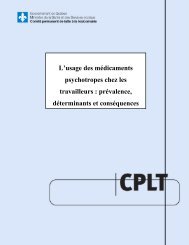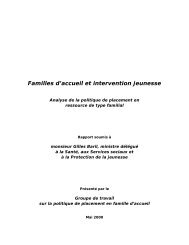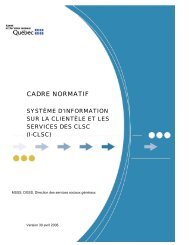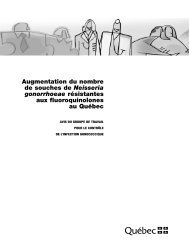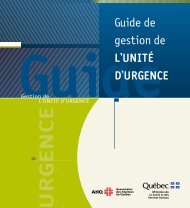De l'innovation au changement - Gouvernement du Québec
De l'innovation au changement - Gouvernement du Québec
De l'innovation au changement - Gouvernement du Québec
Create successful ePaper yourself
Turn your PDF publications into a flip-book with our unique Google optimized e-Paper software.
Projet 16<br />
Impact of a discharge coordinator on the sucessful discharge<br />
of elderly patients from the emergency department (ED),région de Montréal<br />
Impact d’un coordonnateur des congés <strong>au</strong> département d’urgence (DU)<br />
sur le succès <strong>du</strong> congé des patients âgés<br />
(95%CI 1.03-1.56) when a discharge coordinator is involved.<br />
Quality of Service: The study impacted the quality of discharge care offered to elderly patients and their families on several levels. To the<br />
patient and family, the nursing intervention improved the comprehensiveness and clarity of discharge instructions. Patients in the<br />
intervention group expressed a significantly higher level of satisfaction across all aspects of the discharge teaching as compared to usual<br />
care.<br />
Anticipatory guidance with respect to care at home and symptom management potentially avoided an unnecessary return visit.<br />
Furthermore, for the first time, care of the patient who presented to the ED was extended beyond the hospital walls. The intervention model<br />
created a system to address patient concerns, if any, after discharge. Follow up phone calls con<strong>du</strong>cted by the discharge nurse provided<br />
the bridge between the ED and community care. Patient and family concerns were addressed in a timely and efficient manner and<br />
potential problems were detected early. Patients stated that they felt that they “mattered” and that “someone cared”.<br />
Facilitating Integration/Coordination With Other Parts of the Health Care System : The major benefit of the intervention model was that it<br />
identified and specified a structured nursing role for the coordination of discharge and integration of services. The link between the<br />
community and the ED was better identified. Referrals from other health professionals are often transmitted with the nursing history<br />
component left blank. With the implementation of the discharge nurse, referrals were completed in a timely manner and transmitted with all<br />
the appropriate nursing information included. This allowed the CLSC to institute services safely and efficiently. The CLSC now had a<br />
contact person, who had access to the pertinent information, to whom they could address questions and concerns.<br />
At least three variables do show an increase in satisfaction at the intervention phase as compared to control. For example, those patients<br />
who are depressed and those with very severe chief complaints report more satisfaction in the intervention phase. It might be concluded<br />
that higher satisfaction in this category of patient was as a result of more attention provided by the discharge nurse.<br />
Clarity : There is an, albeit small, but significant difference in the composite score for clarity of information provided. Namely, more patients<br />
in the intervention phase report that the information provided to them was clear to very clear.<br />
Usefulness of information provided at discharge : There is a small difference in perceived usefulness of information between the<br />
intervention and control phase measured 8 days post discharge. However, this difference is not in the desired direction. The intervention<br />
phase report that the information provided about symptom management, medication side effects and progress of symptoms was less<br />
useful.<br />
Satisfaction with discharge process: Here too, we find no significant difference with respect to satisfaction with overall process of<br />
discharge. However, looking at the indivi<strong>du</strong>al components of this variable we find a significant increase in satisfaction with the<br />
preparedness for discharge ie. information transmitted to the patient and family at discharge(11.5% p=





